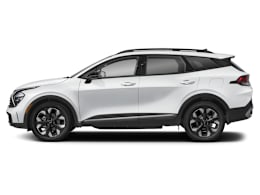The Sportage plug-in hybrid electric vehicle (PHEV) takes the Sportage Hybrid model a step further, thanks to the ability to drive under electric power for an EPA-estimated 34 miles before it transitions to regular hybrid operation. We think the Sportage is one of the better small SUV PHEVs, thanks to its well-integrated hybrid system that makes it a pleasure to drive. But, as with some other PHEVs, the Sportage is less efficient than the standard hybrid model once the electric power runs dry.
For consumers new to PHEVs, these are hybrids with larger batteries that can be plugged into a standard 120-volt household outlet, or a 240-volt EV charger. This gives the vehicle a dedicated electric-only driving range (typically for about 20 to 40 miles, depending on the model) for commuting and running errands, which is something that regular hybrids can’t do. When the battery is drained, the vehicle switches to regular hybrid operation. This also means that, unlike a full battery-electric vehicle, there is no need to find a public charger on a long trip because the gas engine takes over once the electric range is used up.
For buyers who are nervous about going all-in for an EV, a plug-in hybrid could be a logical and cautious first step toward electrification. PHEVs make especially good sense if you have a short commute to work, rarely drive long distances, and have the ability and willingness to plug in your vehicle at home to charge overnight—it’s bound to save you lots of money at the gas pump. Plus, unlike regular hybrids, a PHEV may be eligible for federal tax credits. Considering that the average American drives less than 40 miles per day, this means many people will be able to do most of their daily commute on electric power while reserving the gas engine for longer trips.
The Sportage PHEV’s powertrain consists of a 1.6-liter turbocharged four-cylinder engine, a six-speed automatic transmission, an electric motor, a larger battery than the regular hybrid, and standard all-wheel drive. Total system output is a hearty 261 horsepower. We found it pretty easy to remain under electric propulsion (when we had a charged battery) when driving around town or cruising along on regular two-lane roads. For bigger power demands, such as when accelerating to merge onto a highway, the gas engine turns on to summon forth all of the SUV’s available oomph.
And the Sportage PHEV is fairly quick when it does that, zipping from 0 to 60 mph in 7.4 seconds—a 0.3-second improvement over the regular Sportage Hybrid.
Thanks to its electric drive, the Sportage PHEV initially takes off from a stop in a silky, gentle fashion. But there are times when the system isn’t as smooth as we’d like. For example, if you step pretty hard on the accelerator pedal from a stop it takes off under electric power as usual, but then it brings the gas engine into the flow rather abruptly—both in terms of the sound it makes, as well the way it surges forward more than you were expecting. As we’ve noticed with some other PHEVs that use an automatic transmission rather than an electronic continuously variable transmission (eCVT), it can seem strange to feel the Sportage upshift when it’s using electric power—the one-two shift is particularly noticeable. This will seem especially odd for anyone who is used to driving EVs.
When the Sportage PHEV’s 13.8-kilowatt-hour battery gets depleted, the little SUV then behaves like a regular hybrid, transitioning seamlessly back and forth between gas and electric power as needed. It managed 31 mpg overall in our tests when operating as a hybrid with a depleted battery, which is 4-mpg less than the regular Sportage Hybrid. That’s mostly because of the extra 330 pounds the PHEV is carrying due to its larger battery. This means you’ll only benefit from the PHEV’s efficiency if you plan to plug in often in order to maximize the electric miles. It takes about two-and-a-half hours to recharge the Sportage PHEV on a 240-volt (Level 2) EV charger. You can get away with using a standard 120-volt household outlet, as well, which took us just under 11 hours using the included charging cable. This allows owners to avoid the expense of buying and installing a dedicated EV charger for their garage.
Most other aspects of the PHEV mirror the Sportage line. We appreciate its accurate, well-weighted steering and responsive, nimble handling. It’s also one of the better-riding compact SUVs, with a firm yet steady suspension that does a good job absorbing most bumps. The cabin is relatively quiet for the class, and, as you’d expect, is particularly hushed when using only the electric power.
It managed competitive stopping distances during our panic-brake testing, and we’re happy to report that, beyond some grabbiness during low-speed driving, the pedal feels quite normal, without the sponginess or non-linearity that many hybrids suffer from due to their regenerative-braking systems. The driving position delivers a commanding view out, along with plenty of headroom and well-placed armrests, but the plastic center console intrudes on the driver’s right knee space. The front seats are firm and supportive. The generous rear seat rivals the Honda CR-V and Subaru Forester, with lots of head- and knee room, along with plenty of foot space under the front seats. The cargo area is ample, too, despite the SUV’s swoopy styling. For the most part the cabin is well done with quality materials, stylish controls, and a slick, upscale appearance for the class. The interior looks very high-tech, highlighted by a display screen that spans nearly three-quarters of the dashboard. There’s also lots of glossy-black plastic on the center console, burly-looking door latches, and the fluid way the dashboard air vents move.The aforementioned infotainment touchscreen has large, simple-to-decipher icons and features standard wireless Android Auto and Apple CarPlay functionality. The Sportage’s “monostable” rotary gear selector can be unintuitive to use at first.
Standard active safety and driver assistance features include automatic emergency braking with pedestrian detection, automatic emergency braking that operates at highway speeds, blind spot warning, rear cross traffic warning, reverse automatic emergency braking, lane centering assistance, lane departure warning, lane keeping assistance, adaptive cruise control, and automatic high beams.























